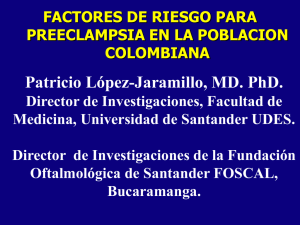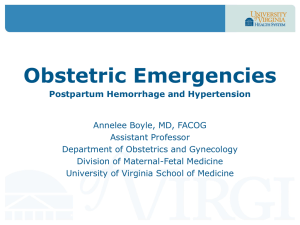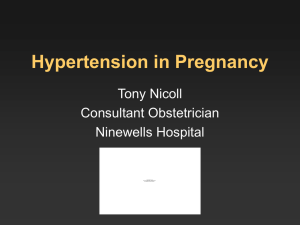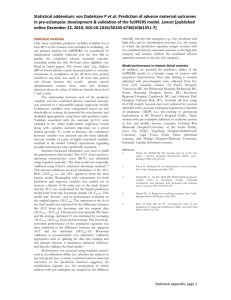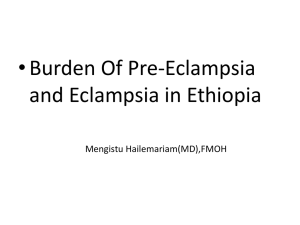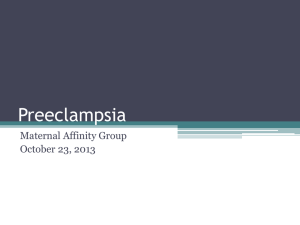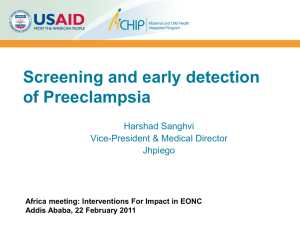Identifying women with risk factors for pre
advertisement
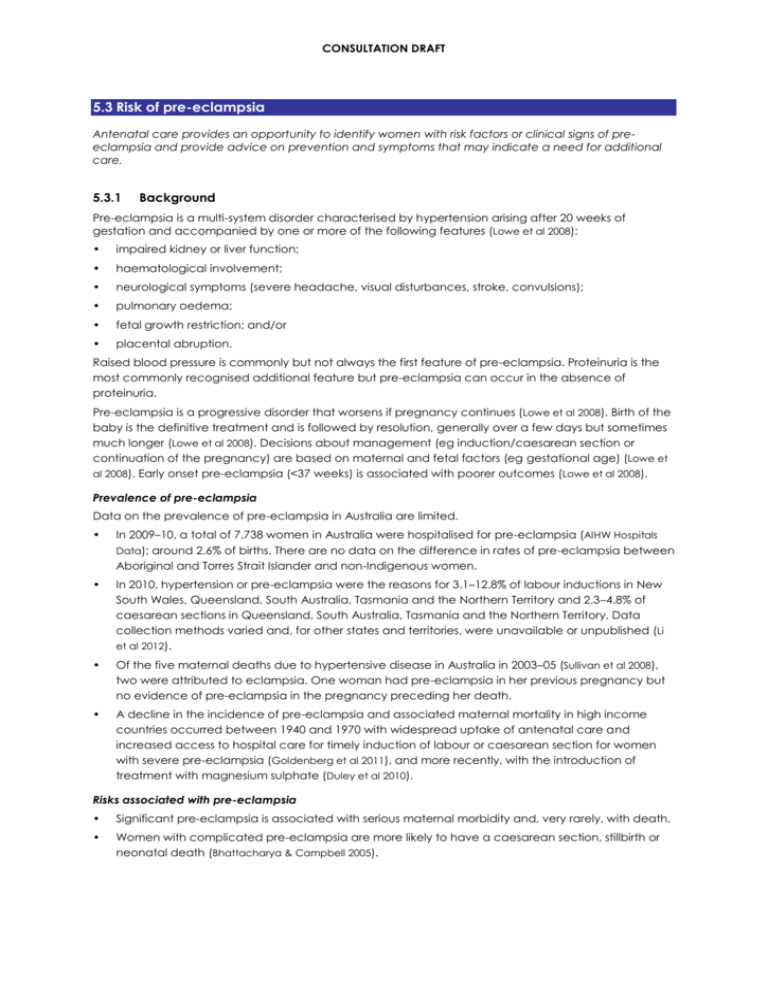
CONSULTATION DRAFT 5.3 Risk of pre-eclampsia Antenatal care provides an opportunity to identify women with risk factors or clinical signs of preeclampsia and provide advice on prevention and symptoms that may indicate a need for additional care. 5.3.1 Background Pre-eclampsia is a multi-system disorder characterised by hypertension arising after 20 weeks of gestation and accompanied by one or more of the following features (Lowe et al 2008): • impaired kidney or liver function; • haematological involvement; • neurological symptoms (severe headache, visual disturbances, stroke, convulsions); • pulmonary oedema; • fetal growth restriction; and/or • placental abruption. Raised blood pressure is commonly but not always the first feature of pre-eclampsia. Proteinuria is the most commonly recognised additional feature but pre-eclampsia can occur in the absence of proteinuria. Pre-eclampsia is a progressive disorder that worsens if pregnancy continues (Lowe et al 2008). Birth of the baby is the definitive treatment and is followed by resolution, generally over a few days but sometimes much longer (Lowe et al 2008). Decisions about management (eg induction/caesarean section or continuation of the pregnancy) are based on maternal and fetal factors (eg gestational age) (Lowe et al 2008). Early onset pre-eclampsia (<37 weeks) is associated with poorer outcomes (Lowe et al 2008). Prevalence of pre-eclampsia Data on the prevalence of pre-eclampsia in Australia are limited. • In 2009–10, a total of 7,738 women in Australia were hospitalised for pre-eclampsia (AIHW Hospitals Data); around 2.6% of births. There are no data on the difference in rates of pre-eclampsia between Aboriginal and Torres Strait Islander and non-Indigenous women. • In 2010, hypertension or pre-eclampsia were the reasons for 3.1–12.8% of labour inductions in New South Wales, Queensland, South Australia, Tasmania and the Northern Territory and 2.3–4.8% of caesarean sections in Queensland, South Australia, Tasmania and the Northern Territory. Data collection methods varied and, for other states and territories, were unavailable or unpublished (Li et al 2012). • Of the five maternal deaths due to hypertensive disease in Australia in 2003–05 (Sullivan et al 2008), two were attributed to eclampsia. One woman had pre-eclampsia in her previous pregnancy but no evidence of pre-eclampsia in the pregnancy preceding her death. • A decline in the incidence of pre-eclampsia and associated maternal mortality in high income countries occurred between 1940 and 1970 with widespread uptake of antenatal care and increased access to hospital care for timely induction of labour or caesarean section for women with severe pre-eclampsia (Goldenberg et al 2011), and more recently, with the introduction of treatment with magnesium sulphate (Duley et al 2010). Risks associated with pre-eclampsia • Significant pre-eclampsia is associated with serious maternal morbidity and, very rarely, with death. • Women with complicated pre-eclampsia are more likely to have a caesarean section, stillbirth or neonatal death (Bhattacharya & Campbell 2005). CONSULTATION DRAFT • Neonatal complications associated with pre-eclampsia in a large cross-sectional study (n=647,392)(Schneider 2011) were small for gestational age, acute respiratory distress syndrome, postpartum neonatal hypoglycemia and low Apgar scores. 5.3.2 Screening for risk of pre-eclampsia Summary of the evidence Whether a woman will require additional care is based on the presence of risk factors for and clinical features of pre-eclampsia. Identifying women with risk factors for pre-eclampsia Identifying risk factors for pre-eclampsia at the first antenatal visit to allow additional care to be arranged is recommended in the United Kingdom (NICE 2008; 2010) and Canada (SOGC 2008). Factors associated with a high risk of pre-eclampsia include (NICE 2008): • a history of pre-eclampsia (Mendilcioglu et al 2004; Lain et al 2005; Ananth et al 2007; Poon et al 2010; Sibai et al 2011); • pre-existing hypertension (Lowe et al 2008; Poon et al 2010); • pre-existing kidney disease; • pre-existing or gestational diabetes (Bryson et al 2003; Yogev et al 2004; Ostlund et al 2006; HAPO 2010); • autoimmune disease such as systemic lupus erythematosis or antiphospholipid syndrome; and • raised blood pressure at the first antenatal visit. Factors associated with a moderate risk of pre-eclampsia include (NICE 2008): • first or multiple pregnancy (eg twins or triplets); • age >40 years; • more than 10 years since the last pregnancy; • BMI greater than 35 kg/m2 at first visit (O’Brien et al 2003; Bodnar et al 2005; Erez-Weiss et al 2005; Fredrick et al 2006; Cnossen et al 2007; Getahun et al 2007; Becker et al 2008; Driul et al 2008; Aliyu et al 2010; Briese et al 2010; Mbah et al 2010; Anderson et al 2012); and • family history of pre-eclampsia (Poon et al 2010) or hypertensive disease (Qiu et al 2004; Roes et al 2005; Bezerra et al 2010; Jelin et al 2010). Risk of pre-eclampsia may also be associated with use of ovulation induction medication and African or Indian subcontinent origin (Poon et al 2010) and Factor V Leiden (Kosmas et al 2003; Dudding et al 2008). While there may be an association between active maternal periodontal disease during pregnancy and pre-eclampsia (Boggess et al 2003), treatment of peridontal disease does not appear to affect the level of risk (Newnham et al 2009) (see Section 10.5 of Module I). Consensus-based recommendation v Routinely measure blood pressure to identify new onset hypertension. CONSULTATION DRAFT Preventive measures Preventive treatment with low-dose aspirin in women at high risk and calcium supplementation in women with low dietary intake is recommended in the United Kingdom (NICE 2010), Canada (SOGC 2008) and Australia (Lowe et al 2008) and by WHO (2011). • Calcium: There is strong evidence that calcium supplementation is of benefit for women at risk of pre-eclampsia if dietary intake is low (Hofmeyr et al 2010; Patrelli 2012). The WHO defines low dietary intake as <900 mg per day and the Australian and New Zealand Nutrient Reference Values recommend an intake of 1,000 mg per day in pregnant women, 1,300 mg if they are younger than 18 years (NHMRC 2005). In Australia, calcium intake is low in relation to recommendations for some girls and women of reproductive age (NHMRC 2011). The sources and recommended number of serves of calcium-rich foods during pregnancy are discussed in Section Error! Reference source not found.. Recommendation 5 Grade A Advise women at high risk of developing pre-eclampsia that calcium supplementation is beneficial if dietary intake is low. Practice point e If a woman has a low dietary calcium intake, advise her to increase her intake of calcium-rich foods. • Effectiveness of aspirin in preventing pre-eclampsia: Systematic reviews and meta-analyses have found that: — low-dose aspirin has moderate benefits when used for prevention of pre-eclampsia (RR: 0.78; 95%CI: 0.67–0.90) (Duley et al 2007); — there was a reduction in risk among women at risk (eg with previous pre-eclampsia) (RR: 0.79; 95%CI: 0.65–0.97) but not those with low risk (Trivedi 2011); and — administration of low-dose aspirin at or before 16 weeks gestation reduced the risk of preeclampsia (RR: 0.47; 95%CI: 0.34–0.65) [Bujold et al 2010], although a systematic review only found a significant effect for preterm pre-eclampsia (RR 0.11, 95% CI 0.04–0.33) (Roberge et al 2012). Recommendation 6 Grade B Advise women at risk of pre-eclampsia that low-dose aspirin from early pregnancy (preferably before 16 weeks) may be of benefit in its prevention. • Vitamins: There is insufficient evidence that the risk of pre-eclampsia is reduced by supplementing vitamin B2 (Neugebauer et al 2006) or vitamins C and E (Beazley et al 2005; Rumbold & Crowther 2005; Poston et al 2006; Rumbold et al 2006; Polyzos et al 2007; Spinnato et al 2007; Klemmensen et al 2009; Rahimini et al 2009; Basaran et al 2010; Xu et al 2010; Conde-Agudelo et al 2011; Rossi & Mullin 2011; Salles et al 2012). These supplements may cause harm (see Section Error! Reference source not found.). Recommendation 7 Grade B Advise women that vitamins are not of benefit in preventing pre-eclampsia. • Physical activity: A systematic review found a trend towards a protective effect from leisure time or recreational physical activity during pregnancy in case-control studies (OR: 0.77; 95%CI: 0.64–0.91) but no significant effect in prospective cohort studies (Kasawara 2012). Physical activity during pregnancy has general health benefits (see Section Error! Reference source not found.). • Salt intake: Reducing salt intake does not reduce the risk of pre-eclampsia (Duley et al 2005). CONSULTATION DRAFT Identifying women with clinical signs of pre-eclampsia Routine measurement of diastolic and systolic blood pressure and testing for proteinuria at each antenatal visit are recommended in the United Kingdom to screen for pre-eclampsia (NICE 2008). However, routine screening for proteinuria is not recommended in the United States (USPSTF 1996; ACOG 2002) or Canada (CTFPHE 1996). • Hypertension: Women with new onset hypertension (defined as a blood pressure ≥140 mmHg systolic and/or ≥90 mm diastolic) that occurs after 20 weeks pregnancy should be assessed for signs and symptoms of pre-eclampsia (Lowe et al 2008). • Proteinuria: Routine testing for proteinuria is not helpful in predicting pre-eclampsia and should be confined to women with increased blood pressure or sudden weight gain (Alto 2005; Rhode et al 2007). When testing is indicated, numerous high and low evidence level studies confirm the correlation of protein-creatinine ratio testing against the ‘gold standard’ 24-hour urine collection, for point of care testing (Haas et al 2003; Wikstrom et al 2006; Zadehmodarres et al 2006; Aggarwal et al 2008; Chen et al 2008; Poon et al 2008a; Al et al 2009; Soni et al 2009; Nasrin et al 2010; Sethuram et al 2011; Morris et al 2011; Morris 2012; Tun et al 2012). Urine dipstick tests have high false postive/negative rates and should be confirmed by other tests such as spot urine protein-creatinine ratio (Phelan et al 2004). Measurement of blood pressure and testing for proteinuria is discussed in Module I of the Guidelines (see Sections 7.3 and 7.4). Recommendation 8 Grade C Offer testing for proteinuria if a woman has risk factors for, or clinical indications of, pre-eclampsia; in particular raised blood pressure. Predicting pre-eclampsia A range of measures has been used to further predict risk of pre-eclampsia. These tests are not recommended as they have insufficient sensitivity and specificity (Meads et al 2008). • Uterine artery Doppler: Although some studies have found uterine artery Doppler to be useful in predicting pre-eclampsia when used alone (Gomez et al 2006; Pilalis et al 2007; Ghosh et al 2012) or in combination with other markers (Cnossen et al 2008a; Giguere et al 2010; Pedrosa & Matias 2011) or predictive modelling (Audibert et al 2005; Papageorghiou et al 2005; Onalan et al 2006; Sritippayawan & Phupong 2007; Diab 2008; Poon et al 2009; Kuc 2011), there is insufficient evidence to recommend its use to predict pre-clampsia. • Serum uric acid: While rising serum uric acid is associated with severe pre-eclampsia (NICE 2008) the evidence on its validity as a screening or diagnostic test is mixed; one systematic review (n=572) (Cnossen et al 2006) found insufficient evidence to support its use and a subsequent review (n=1,675) (Koopmans et al 2009) concluded that it may be useful for predicting maternal complications. • Prediction index model: A three-step approach to testing (medical examination data, specific haemostasis and coagulation tests and measurement of relative plasma volume) had a satisfactory positive predictive value and cost efficiency ratio in a small analysis of women with and without a history of pre-eclampsia (Emonts et al 2008). • Other predictive tests: There is limited evidence to support identifying women as at risk of preeclampsia based solely on markers for Down syndrome (pregnancy-associated placental protein-A [PAPP-A] and free beta-human chorionic gonadotrophin [-hCG]) (Morris et al 2008; Hui et al 2012) or mean arterial blood pressure (Cnossen et al 2008b; Poon et al 2008b). There is emerging evidence regarding the predictive accuracy of other biomarkers (Kleinrouweler et al 2012), low levels of excreted urinary calcium (Amitava 2012), immunoassays (Benton et al 2011), polymerase chain reaction (PCR) analysis of podocyte-specific molecules (Kelder 2012), intraplacental vascularisation indices (Mihu 2012) and increased plasma D-Dimer levels (Pinheiro et al 2012). Due to the progressive nature of pre-eclampsia and a lack of therapies effective in altering its progression (Lowe et al 2008), these tests are unlikely to change interventions or outcomes (NICE 2008). Section 5.3.5 includes resources on the management of hypertensive disorders in pregnancy. CONSULTATION DRAFT 5.3.3 Discussing risk of pre-eclampsia It is important that women are given information about the symptoms of pre-eclampsia before 20 weeks gestation, or when they first attend for antenatal care if this occurs in the second half of pregnancy. Practice point f Women should be given information about the urgency of seeking advice from a health professional if they experience: • severe headache; • visual disturbance, such as blurring or flashing before the eyes; • severe epigastric pain (just below the ribs); • vomiting; or • rapid swelling of the face, hands or feet. 5.3.4 Practice summary: pre-eclampsia When: A woman has risk factors for pre-eclampsia in the first half or pregnancy or clinical signs in the second half of pregnancy (> 20 weeks gestation). Who: Midwife; GP; obstetrician; Aboriginal and Torres Strait Islander Health Practitioner; Aboriginal and Torres Strait Islander Health Worker; multicultural health worker. Discuss risk factors for pre-eclampsia early in pregnancy: Explain that the risk of pre-eclampsia is increased if a woman has certain risk factors. Discuss pre-eclampsia screening: Explain that if a woman has high blood pressure and/or proteinuria, she will require additional care during the rest of her pregnancy. Discuss symptoms of pre-eclampsia with women at high risk: Explain the importance of seeking medical advice immediately if symptoms occur. Take a holistic approach: Ask women at risk of pre-eclampsia about how many serves of calcium-rich foods they eat each day (see Section Error! Reference source not found.). Discuss low cost and culturally appropriate strategies for increasing calcium intake. Document and follow-up: Note risk factors and the results of blood pressure measurement and proteinuria testing in the woman’s antenatal record. Further investigations may be warranted if increases in blood pressure or new proteinuria are identified at subsequent visits. 5.3.5 Resources ACOG (2002) ACOG Practice Bulletin 33. Diagnosis and Management of Preeclampsia and Eclampsia. Washington, DC: American College of Obstetricians and Gynecologists. Hypertension (high blood pressure) in pregnancy. In: Minymaku Kutju Tjukurpa Women’s Business Manual, 4th edition. Congress Alukura, Nganampa Health Council Inc and Centre for Remote Health. http://www.remotephcmanuals.com.au Lowe SA, Brown MA, Dekker G et al (2008) Guidelines for the management of hypertensive disorders of pregnancy 2008. Society of Obstetric Medicine of Australia and New Zealand. Aust NZ J Obstet Gynaecol 49(3): 242– 46. NICE (2010) Hypertension in Pregnancy: the Management of Hypertensive Disorders during Pregnancy. National Collaborating Centre for Women’s and Children’s Health. Commissioned by the National Institute for Health and Clinical Excellence. London: RCOG Press. SOGC (2008) Diagnosis, Evaluation, and Management of the Hypertensive Disorders of Pregnancy. Clinical Practice Guideline No. 206. Toronto: Society of Obstetricians and Gynaecologists of Canada. 5.3.6 References ACOG (2002) ACOG Practice Bulletin 33. Diagnosis and Management of Preeclampsia and Eclampsia. Washington, DC: American College of Obstetricians and Gynecologists. CONSULTATION DRAFT Aggarwal N, Suri V, Soni S et al (2008) A prospective comparison of random urine protein-creatinine ratio vs 24-hour urine protein in women with preeclampsia. Medscape J Med 10(4): 98. Al RA, Borekci B, Yapca O et al (2009) Albumin/creatinine ratio for prediction of 24-hour albumin excretion of > or =2 g in manifest preeclampsia. Clin Exp Obstet Gynecol 36(3): 169–72. Aliyu MH, Luke S, Kristensen S et al (2010) Joint effect of obesity and teenage pregnancy on the risk of preeclampsia: a population-based study. J Adol Health 46(1): 77–82. Alto W (2005) No need for glycosuria/proteinuria screen in pregnant women. J Fam Pract 54(11): 978–83. Amitava P (2012) A prospective study for the prediction of preeclampsia with urinary calcium level. J Obstet Gynecol India 62(3):312–16. Ananth CV, Peltier MR, Chavez MR et al (2007) Recurrence of ischemic placental disease. Obstet Gynecol 110(1): 128–33. Anderson NH, McCowan LM, Fyfe EM et al (2012) The impact of maternal body mass index on the phenotype of preeclampsia: a prospective cohort study. BJOG 119(5): 589–95. Audibert F, Benchimol Y, Benattar C et al (2005) Prediction of preeclampsia or intrauterine growth restriction by second trimester serum screening and uterine Doppler velocimetry. Fetal Diag Ther 20(1): 48–53. Basaran A, Basaran M, Topatan B (2010) Combined vitamin C and E supplementation for the prevention of preeclampsia: a systematic review and meta-analysis. Obstet Gynecol Surv 65(10): 653–67. Beazley D, Ahokas R, Livingston J et al (2005) Vitamin C and E supplementation in women at high risk for preeclampsia: a double-blind, placebo-controlled trial. Am J Obstet Gynecol 192(2): 520–21. Becker T, Vermeulen MJ, Wyatt PR et al (2008) Maternal obesity and the risk of placental vascular disease. J Obstet Gynaecol Can 30(12): 1132–36. Benton SJ, Hu Y, Xie F et al (2011) Angiogenic factors as diagnostic tests for preeclampsia: a performance comparison between two commercial immunoassays. Am J Obstet Gynecol 205(5): 469–68. Bezerra PCFM, Leao MD, Queiroz JW et al (2010) Family history of hypertension as an important risk factor for the development of severe preeclampsia. Acta Obstet Gynecol Scand 89(5): 612–17. Bhattacharya S & Campbell DM (2005) The incidence of severe complications of preeclampsia. Hypertens Preg 24(2): 181–90. Bodnar LM, Ness RB, Markovic N et al (2005) The risk of preeclampsia rises with increasing prepregnancy body mass index. Annals Epidemiol 15(7): 475–82. Boggess KA, Lieff S, Murtha AP et al (2003) Maternal periodontal disease is associated with an increased risk for preeclampsia. Obstet Gynecol 101(2): 227–31. Briese V, Voigt M, Hermanussen M et al (2010) Morbid obesity: pregnancy risks, birth risks and status of the newborn. Homo 61(1): 64–72. Bryson CL, Ioannou GN, Rulyak SJ et al (2003) Association between gestational diabetes and pregnancy-induced hypertension. Am J Epidemiol 158(12): 1148–53. Bujold E, Roberge S, Lacasse Y et al (2010) Prevention of preeclampsia and intrauterine growth restriction with aspirin started in early pregnancy: a meta-analysis. Obstet Gynecol 116(2 part 1): 401–14. Chen BA, Parviainen K, Jeyabalan A (2008) Correlation of catheterized and clean catch urine protein/creatinine ratios in preeclampsia evaluation. Obstet Gynecol 112(3): 606–10. Cnossen JS, Ruyter-Hanhijärvi H, van der Post JAM et al (2006) Accuracy of serum uric acid determination in predicting pre-eclampsia: a systematic review. Acta Obstet Gynecol Scand 85(5): 519–25. Cnossen JS, Leeflang MMG, de Haan EEM et al (2007) Accuracy of body mass index in predicting pre-eclampsia: bivariate meta-analysis. BJOG 114(12): 1477–85. Cnossen JS, Morris RK, ter Riet G et al (2008a) Use of uterine artery Doppler ultrasonography to predict pre-eclampsia and intrauterine growth restriction: a systematic review and bivariable meta-analysis. J Obstet Gynaecol Can 178(6): 701–11. Cnossen JS, Vollebregt KC, de Vrieze N et al (2008b) Accuracy of mean arterial pressure and blood pressure measurements in predicting pre-eclampsia: systematic review and meta-analysis. Brit Med J 336(7653): 1117–20. Conde-Agudelo A, Romero R, Kusanovic JP et al (2011) Supplementation with vitamins C and e during pregnancy for the prevention of preeclampsia and other adverse maternal and perinatal outcomes: A systematic review and metaanalysis. Am J Obstet Gynecol 204(6): 503. CTFPHE (1996) Canadian Guide to Clinical Preventive Services. Canadian Task Force on the Periodic Health Examination. 2nd ed. Baltimore, Md: Williams and Wilkins. Diab AE (2008) Angiogenic factors for the prediction of pre-eclampsia in women with abnormal midtrimester uterine artery Doppler velocimetry. Int J Gynecol Obstet 102(2): 146–51. Driul L, Cacciaguerra G, Citossi A et al (2008) Prepregnancy body mass index and adverse pregnancy outcomes. Arch Gynecol Obstet 278(1): 23–26. Dudding T, Heron J, Thakkinstian A et al (2008) Factor V Leiden is associated with pre-eclampsia but not with fetal growth restriction: a genetic association study and meta-analysis. J Thromb Haemost 6(11): 1869–75. Duley L, Henderson-Smart D, Meher S (2005) Altered dietary salt for preventing pre-eclampsia, and its complications' Cochrane Database Syst Rev no. 4, p. CD005548. CONSULTATION DRAFT Duley L, Henderson-Smart DJ, Meher S et al (2007) Antiplatelet agents for preventing pre-eclampsia and its complications. Cochrane Database Syst Rev 2007, Issue 2. Art. No.: CD004659. Duley L, Gülmezoglu AM, Henderson-Smart DJ et al (2010) Magnesium sulphate and other anticonvulsants for women with pre-eclampsia. Cochrane Database Syst Rev Issue 11. Art. No.: CD000025. Emonts P, Seaksan S, Seidel L et al (2008) Prediction of maternal predisposition to preeclampsia. Hypertens Preg 27(3): 237–45. Erez-Weiss I, Erez O, Shoham-Vardi I et al (2005) The association between maternal obesity, glucose intolerance and hypertensive disorders of pregnancy in non-diabetic pregnant women. Hypertens Preg 24(2): 125–36. Frederick IO, Rudra CB, Miller RS et al (2006) Adult weight change, weight cycling, and prepregnancy obesity in relation to risk of preeclampsia. Epidemiol 17(4): 428–34. Getahun D, Ananth CV, Oyelese Y et al (2007) Primary preeclampsia in the second pregnancy: effects of changes in pre-pregnancy body mass index between pregnancies. Obstet Gynecol 110(6): 1319–25. Ghosh SK, Raheja S, Tuli A et al (2012) Combination of uterine artery Doppler velocimetry and maternal serum placental growth factor estimation in predicting occurrence of pre-eclampsia in early second trimester pregnancy: a prospective cohort study. Eur J Obstet Gynecol Reprod Biol 161(2): 144–51. Giguere, Y, Charland M, Bujold E et al (2010) Combining biochemical and ultrasonographic markers in predicting preeclampsia: A systematic review. Clin Chem 56(3): 361–75. Goldenberg RL, McClure EM, Macguire ER et al (2011) Lessons for low-income regions following the reduction in hypertension-related maternal mortality in high-income countries. Int J Gynaecol Obstet 113(2): 91–95. Gomez O, Figueras F, Mart¡nez JM et al (2006) Sequential changes in uterine artery blood flow pattern between the first and second trimesters of gestation in relation to pregnancy outcome. Ultrasound Obstet Gynecol 28(6): 802–08. Haas DM, Sabi F, McNamara M et al (2003) Comparing ambulatory spot urine protein/creatinine ratios and 24-h urine protein measurements in normal pregnancies. J Matern-Fetal Neonat Med 14(4): 233–36. HAPO (2010) Hyperglycemia and Adverse Pregnancy Outcome (HAPO) Study: Preeclampsia. Am J Obstet Gynecol 202: 255e1–e7 Hofmeyr GJ, Lawrie TA, Atallah ÁN et al (2010) Calcium supplementation during pregnancy for preventing hypertensive disorders and related problems. Cochrane Database Syst Rev CD001059. Hui D, Okun N, Murphy K et al (2012) Combinations of maternal serum markers to predict preeclampsia, small for gestational age, and stillbirth: a systematic review. JOGC 34(2): 142–53. Jelin AC, Cheng YW, Shaffer BL et al (2010) Early-onset preeclampsia and neonatal outcomes. J Matern Fetal Neonat Med 23(5): 389–92. Kasawara KT (2012) Exercise and physical activity in the prevention of pre-eclampsia: Systematic review. Acta Obstet Gynecol Scand 91(10): 1147–57. Kelder TP (2012) Quantitative polymerase chain reaction-based analysis of podocyturia is a feasible diagnostic tool in preeclampsia. Hypertension 60(6):1538-44. Kleinrouweler CE, Wiegerinck MM, Ris-Stalpers C et al (2012) Accuracy of circulating placental growth factor, vascular endothelial growth factor, soluble fms-like tyrosine kinase 1 and soluble endoglin in the prediction of pre-eclampsia: a systematic review and meta-analysis. BJOG 119(7): 778–87. Klemmensen A, Tabor A, Østerdal ML et al (2009) K Intake of vitamin C and E in pregnancy and risk of preeclampsia: Prospective study among 57 346 women. BJOG 116(7): 964–74. Koopmans CM, van Pampus MG, Groen H et al (2009) Accuracy of serum uric acid as a predictive test for maternal complications in pre-eclampsia: bivariate meta-analysis and decision analysis. Eur J Obstet Gynecol Reprod Biol 146(1: 8–14. Kosmas IP, Tatsioni A, Ioannidis JP (2003) Association of Leiden mutation in factor V gene with hypertension in pregnancy and pre-eclampsia: a meta-analysis. J Hypertens 21(7): 1221–28. Kuc S, Wortelboer EJ, van Rijn BB et al (2011) Evaluation of 7 serum biomarkers and uterine artery doppler ultrasound for first-trimester prediction of preeclampsia: A systematic review. Obstet Gynecol Surv 66(4): 225–39 Lain KY, Krohn MA, Roberts JM (2005) Second pregnancy outcomes following preeclampsia in a first pregnancy. Hypertens Preg 24(2): 159–69. Li Z, Zeki R, Hilder L et al (2012) Australia’s Mothers and Babies 2010. Sydney: Australian Institute for Health and Welfare National Perinatal Epidemiology and Statistics Unit. Lowe SA, Brown MA, Dekker G et al (2008) Guidelines for the management of hypertensive disorders of pregnancy 2008. Society of Obstetric Medicine of Australia and New Zealand. Aust NZ J Obstet Gynaecol 49(3): 242– 46. Mbah AK, Kornosky JL, Kristensen S et al (2010) Super-obesity and risk for early and late pre-eclampsia. BJOG 117(8): 997–1004. Meads CA, Cnossen JS, Meher S et al (2008) Methods of prediction and prevention of pre-eclampsia: systematic reviews of accuracy and effectiveness literature with economic modelling. Health Technol Assess 12(6): iii–iv, 1–270. CONSULTATION DRAFT Mendilcioglu I, Trak B, Uner M et al (2004) Recurrent preeclampsia and perinatal outcome: a study of women with recurrent preeclampsia compared with women with preeclampsia who remained normotensive during their prior pregnancies. Acta Onstet Gynecol Scand 83(11): 1044–48. Mihu CM (2012) Contribution of 3D power Doppler ultrasound to the evaluation of placental circulation in normal pregnancies and pregnancies complicated by preeclampsia. J Perinat Med 40(2012): 359–64. Morris RK, Cnossen J, Langejans M et al (2008) Serum screening with Down's Syndrome markers to predict preeclampsia and small for gestational age: Systematic review and meta-analysis. BMC Preg Childbirth 8(1): 33. Morris RK, Doug M, Kilby MD (2011) A systematic review and meta-analysis of the diagnostic accuracy of the spot urinary Protein Creatinine Ratio (PCR) and the spot urinary Albumin Creatinine Ratio (ACR) in the management of suspected pre-eclampsia. Arch Dis Child Fetal Neonatal Ed 96: Fa98. Morris RK, Riley RD, Doug M et al (2012) Diagnostic accuracy of spot urinary protein and albumin to creatinine ratios for detection of significant proteinuria or adverse pregnancy outcome in patients with suspected preeclampsia: systematic review and meta-analysis. BMJ 345: e4342. Nasrin B, Fatema N, Jebunnessa F et al (2010) Early pregnancy maternal serum PAPP-A and urinary proteincreatinine ratio as predictive markers of pregnancy induced hypertension. MMJ 19(2): 267–74. Neugebauer J, Zanre Y, Wacker J (2006) Riboflavin supplementation and preeclampsia. Int J Gynaecol Obstet 93(2): 136–37. Newnham JP, Newnham IA, Ball CM et al (2009) Treatment of periodontal disease during pregnancy: a randomized controlled trial. Obstet Gynecol 114(6): 1239–48. NHMRC (2005) Nutrient Reference Values for Australia and New Zealand. Canberra: National Health and Medical Research Council. http://www.nhmrc.gov.au/_files_nhmrc/publications/attachments/n35.pdf NHMRC (2011) A Modelling System to Inform the Revision of the Australian Guide to Healthy Eating. Canberra: Commonwealth of Australia. NICE (2008) Antenatal Care. Routine Care for the Healthy Pregnant Woman. National Collaborating Centre for Women’s and Children’s Health. Commissioned by the National Institute for Health and Clinical Excellence. London: RCOG Press. NICE (2010) Hypertension in Pregnancy: the Management of Hypertensive Disorders during Pregnancy. National Collaborating Centre for Women’s and Children’s Health. Commissioned by the National Institute for Health and Clinical Excellence. London: RCOG Press. O'Brien TE, Ray JG, Chan WS (2003) Maternal body mass index and the risk of preeclampsia: a systematic overview. Epidemiol 14(3): 368–74. Onalan R, Onalan G, Gunenc Z et al (2006) Combining 2nd-trimester maternal serum homocysteine levels and uterine artery Doppler for prediction of preeclampsia and isolated intrauterine growth restriction. Gynecol Obstet Invest 61(3): 142–48. Ostlund, I, Haglund, B, Hanson, U (2004) Gestational diabetes and preeclampsia. Eur J Obstet Gynecol Reprod Biol 113(1): 12–16. Papageorghiou AT, Yu CKH, Erasmus IE et al (2005) Assessment of risk for the development of pre-eclampsia by maternal characteristics and uterine artery Doppler. BJOG: 112(6): 703–09. Patrelli TS (2012) Calcium supplementation and prevention of preeclampsia: A meta-analysis. J Matern Fetal Neonatal Med 25(12): 2570–74. Pedrosa AC & Matias A (2011) Screening for pre-eclampsia: a systematic review of tests combining uterine artery Doppler with other markers. J Perinat Med 39(6): 619–15. Pinheiro M de B, Junqueira DR, Coelho FF et al (2012) D-dimer levels and preeclampsia: A systematic review. Clin Chim Acta 414: 166–70. Phelan LK, Brown MA, Davis GK et al (2004) A prospective study of the impact of automated dipstick urinalysis on the diagnosis of preeclampsia. Hypertens Preg 23(2): 135–42. Pilalis A, Souka AP, Antsaklis P et al (2007) Screening for pre-eclampsia and small for gestational age fetuses at the 11-14 weeks scan by uterine artery Dopplers. Acta Obstet Gynecol Scand 86(5): 530–34. Polyzos NP, Mauri D, Tsappi M et al (2007) Combined vitamin C and E supplementation during pregnancy for preeclampsia prevention: a systematic review. Obstet Gynecol Surv 6(3): 202–06. Poon LCY, Kametas N, Bonino S et al (2008a) Urine albumin concentration and albumin-to-creatinine ratio at 11(+0) to 13(+6) weeks in the prediction of pre-eclampsia. BJOG 115(7): 866–73. Poon LCY, Kametas NA, Pandeva I et al (2008b) Mean arterial pressure at 11(+0) to 13(+6) weeks in the prediction of preeclampsia. Hypertens 51(4): 1027–33. Poon LCY, Karagiannis G, Leal A et al (2009) Hypertensive disorders in pregnancy: screening by uterine artery Doppler imaging and blood pressure at 11-13 weeks. Ultrasound Obstet Gynecol 34(5): 497–502. Poon LCY, Kametas NA, Chelemen T et al (2010) Maternal risk factors for hypertensive disorders in pregnancy: a multivariate approach. J Human Hypertens 24(2): 104–10. Poston L, Briley AL, Seed PT et al (2006) Vitamin C and vitamin E in pregnant women at risk for pre-eclampsia (VIP trial): randomised placebo-controlled trial. Lancet 367(9517): 1145–54. CONSULTATION DRAFT Qiu C, Luthy DA, Zhang C et al (2004) A prospective study of maternal serum C-reactive protein concentrations and risk of preeclampsia. Am J Hypertens 17(2): 154–60. Rahimi R, Nikfar S, Rezaie A (2009) A meta-analysis on the efficacy and safety of combined vitamin C and E supplementation in preeclamptic women vitamin C and e supplements in preeclamptic women. Hypertens Preg 28(4): 417–34. Rhode MA, Shapiro H, Jones, 3rd OW (2007) Indicated vs. routine prenatal urine chemical reagent strip testing. J Reprod Med 52(3): 214–19. Roberge S, Villa P, Nicolaides K et al (2012) Early administration of low-dose aspirin for the prevention of preterm and term preeclampsia: a systematic review and meta-analysis. Fetal Diag Ther 31(3): 141–46. Roes EM, Sieben R, Raijmakers MTM et al (2005) Severe preeclampsia is associated with a positive family history of hypertension and hypercholesterolemia. Hypertens Pregnancy 24(3): 259–71. Rossi AC & Mullin PM (2011) Prevention of pre-eclampsia with low-dose aspirin or vitamins C and E in women at high or low risk: A systematic review with meta-analysis. Eur J Obstet Gynecol Reprod Biol 158: 9–16. Rumbold A & Crowther CA (2005) Vitamin E supplementation in pregnancy. Cochrane Database Syst Rev no. 2, p CD004069. Rumbold AR, Crowther CA, Haslam RR et al (2006) Vitamins C and E and the risks of preeclampsia and perinatal complications. New Engl J Med 354(1); 1796–1806. Salles AM, Galvao TF, Silva MT et al (2012) Antioxidants for preventing preeclampsia: a systematic review. Sci World J 2012: 243476. Schneider S, Freerksen N, Maul H et al (2011) Risk groups and maternal-neonatal complications of preeclampsia Current results from the national German Perinatal Quality Registry. J Perinatal Med 39(3): 257–63. Sethuram R, Kiran TSU, Weerakkody ANA (2011) Is the urine spot protein/creatinine ratio a valid diagnostic test for pre-eclampsia? J Obstet Gynaecol 31(2): 128–30. Sibai BM, Koch MA, Freire S et al (2011) The impact of prior preeclampsia on the risk of superimposed preeclampsia and other adverse pregnancy outcomes in patients with chronic hypertension. Am J Obstet Gynecol 204(4): 345 SOGC (2008) Diagnosis, Evaluation, and Management of the Hypertensive Disorders of Pregnancy. Clinical Practice Guideline No. 206. Toronto: Society of Obstetricians and Gynaecologists of Canada. Soni S, Aggarwal N, Dhaliwal L et al (2009) Correlation of 2-hour and 4-hour urinary proteins with 24-hours proteinuria in hospitalized patients with preeclampsia. Hypertens Preg 28(1): 109–18. Spinnato JA, Freire S, Pinto e Silva JL et al (2007) Antioxidant therapy to prevent preeclampsia: a randomized controlled trial. Obstet Gynecol 110(6): 1311–18. Sritippayawan S & Phupong V (2007) Risk assessment of preeclampsia in advanced maternal age by uterine arteries Doppler at 17-21 weeks of gestation. J Med Assoc Thailand 90(7): 1281–86. Sullivan EA, Hall B, King JF (2007) Maternal Deaths in Australia 2003–2005. Maternal deaths series no 3, Cat PER 42. Sydney: AIHW Perinatal Statistics Unit. Trivedi NA (2011) A meta-analysis of low-dose aspirin for prevention of preeclampsia. J Postgrad Med 57(2): 91–95. Tun C, Quinones JN, Kurt A et al (2012) Comparison of 12-hour urine protein and protein:creatinine ratio with 24-hour urine protein for the diagnosis of preeclampsia. Am J Obstet Gynecol 207(3): 233–38. USPTF (1996) Screening for Preeclampsia. Guide to Clinical Preventive Services. 2nd ed. Baltimore, Md: Williams and Wilkins. WHO (2011) World Health Organization Recommendations for Prevention and Treatment of Pre-eclampsia and Eclampsia. Geneva: World Health Organization. Wikstrom AK, Wikstrom J, Larsson A et al (2006) Random albumin/creatinine ratio for quantification of proteinuria in manifest pre-eclampsia. BJOG 113(8): 930–34. Xu H, Perez-Cuevas R, Xiong X et al (2010) An international trial of antioxidants in the prevention of preeclampsia (INTAPP). Am J Obstet Gynecol 202(239): e1-10. Yogev Y, Langer O, Brustman L et al (2004) Pre-eclampsia and gestational diabetes mellitus: does a correlation exist early in pregnancy? J Matern-Fetal Neonat Med 15(1): 39–43. Zadehmodarres S, Razzaghi MR, Habibi G et al (2006) Random urine protein to creatinine ratio as a diagnostic method of significant proteinuria in pre-eclampsia. Aust NZ J Obstet Gynaecol 46(6): 501–04.
